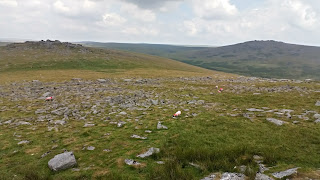I've been hearing and reading plenty lately about the environmental impact of our roads. Whether it be air pollution, biodiversity on our verges, or routes through protected landscapes, subject matter has been everywhere. Now, to my shame, I drive lots, especially on my commute to and from Dartmoor. Yet recent walks (and drives) have made got me thinking, in this case, about where I parked. Forgive me if this goes a bit off topic...
A loop of the Staple Tors above the Walkham Valley was in order. I was searching for a birthday series sited for a highly regarded, well respected veteran of the hobby. It was a walk during the June/July heatwave (set to make a return in August!) The past few months have seen a glorious spell of hot, dry conditions on the Moor.

Low river levels, drier marshy areas, parched grass Letterbox plugs. OK - so not everyone was happy with the weather, but it suited me. This was my first Letterbox walk in some time. I'd missed Ten Tors, cuckoos, cotton grass and bluebells. I was returning to the season of horse flies and bracken. Packed and dressed accordingly, with extra fluids on board, I was anticipating a breathless ramble.
The car park I headed for was beneath, and on the same side of the road as Little Staple Tor, overlooking Vixen Tor. At the back of the parking area is an enormous granite boulder. Upon it, though suffering from age and clear vandalism, is inscribed the following:
THIS VIEWPOINT PARKING AREA HAS BEEN CONSTRUCTED BY THE REES JEFFREYS ROAD FUND
This is known locally as - rather obviously - the Rees Jeffreys car park.
This got me thinking. I was vaguely aware of the name this car park had, but no how that came about. This memorial lead me to the story of William Rees Jeffreys, perhaps the most powerful and influential voices in recent UK transport history. Born in 1872, Rees Jefferys: mechanical engineer; keen cyclist; campaigner for safer roads and supporter of using an aesthetically kind transport infrastructure to connect people with the countryside for recreation. He was Secretary of the RAC, Secretary of the Cylists Touring Club, but most importantly, Secretary for Roads when the Ministry of Transport came about in 1919.

It was WRJ who championed the sealing of the UK road network, a system which was previously dusty during the Summer, muddy in the Winter, and always a noise nuisance. He promoted the First Severn bridge. He pushed for a UK Road Classification System, dividing the UK into 9 areas, and resulted in all major routes in the South West beginning in the number 3 (A30, A39, A386 etc). WRJ was an exponent of road safety, investing heavily upgrading what he considered an inadequate and hazardous road network in the 1920s and '30s. In 1937 Prime Minister Lloyd George described WRJ as "the greatest authority on roads in the United Kingdom and one of the greatest in the whole world".

Ahem. Back to my Letterbox walk though. The SSW'ly breeze was in evidence throughout the walk, combined with building clouds, helping to keep me cool. The route was generous on Letterboxes, and, still dreaming of hitting the 16000 landmark this decade, I was grateful of this. I sought more sheltered corner for lunch, out of the wind and perhaps ironically, away from the ever-present road noise!
It wasn't much of a social experience though. I didn't see another soul walking all day. On current evidence, perhaps the work of Rees Jefferys to link people with the beauty of the countryside had gone to waste.

Or maybe not. Upon his death in 1954, a legacy trust fund was set up, to help fund training, research and projects which improve the highway network and roadside environment. Aims include a better and safer system with an enhanced experience for road users.
The fund accepts applications for funds via their webpage (http://www.reesjeffreys.co.uk/) and publishes annual reports. These are available for every year back except 1955-1962, when interestingly the trustee board admit they don't know who got what, and ask the public if they have a copy they could have!
Besides Dartmoor car parks, the breadth and range of investment projects is heartening. For example, in 2017, the Royal Society of Wildlife Trusts was granted £28,000 for a 3 year project tackling flooding through roadside wildflower planting. A noble cause.
I considered my day out as I drove West into the sunset. 14 Letterboxes found.





















































